| 登録情報 | データベース: PDB / ID: 4nty
|
|---|
| タイトル | Cesium sites in the crystal structure of acid-sensing ion channel in complex with snake toxin |
|---|
 要素 要素 | - Acid-sensing ion channel 1
- Basic phospholipase A2 homolog Tx-beta
- Neurotoxin MitTx-alpha
|
|---|
 キーワード キーワード | TRANSPORT PROTEIN/TOXIN / Kunitz / phospholipase A2-like / ion channel / nociception / membrane / TRANSPORT PROTEIN-TOXIN complex |
|---|
| 機能・相同性 |  機能・相同性情報 機能・相同性情報
Stimuli-sensing channels / pH-gated monoatomic ion channel activity / cellular response to pH / ion channel regulator activity / : / ligand-gated sodium channel activity / arachidonate secretion / lipid catabolic process / phospholipid metabolic process / sodium ion transmembrane transport ...Stimuli-sensing channels / pH-gated monoatomic ion channel activity / cellular response to pH / ion channel regulator activity / : / ligand-gated sodium channel activity / arachidonate secretion / lipid catabolic process / phospholipid metabolic process / sodium ion transmembrane transport / serine-type endopeptidase inhibitor activity / phospholipid binding / toxin activity / postsynaptic membrane / calcium ion binding / dendrite / extracellular region / identical protein binding / plasma membrane類似検索 - 分子機能 Acid-sensing ion channel domain / acid-sensing ion channel 1 fold / acid-sensing ion channel 1 domain / Acid-sensing ion channels like fold / Acid-sensing ion channels like domains / YojJ-like / Epithelial sodium channel, chordates / Epithelial sodium channel, conserved site / Amiloride-sensitive sodium channels signature. / Epithelial sodium channel ...Acid-sensing ion channel domain / acid-sensing ion channel 1 fold / acid-sensing ion channel 1 domain / Acid-sensing ion channels like fold / Acid-sensing ion channels like domains / YojJ-like / Epithelial sodium channel, chordates / Epithelial sodium channel, conserved site / Amiloride-sensitive sodium channels signature. / Epithelial sodium channel / Amiloride-sensitive sodium channel / Pancreatic trypsin inhibitor Kunitz domain / Factor Xa Inhibitor / Phospholipase A2, aspartic acid active site / Phospholipase A2 aspartic acid active site. / Phospholipase A2 / Phospholipase A2 / Phospholipase A2 domain / Phospholipase A2 / Phospholipase A2 / Phospholipase A2 domain / Phospholipase A2 domain superfamily / BPTI/Kunitz family of serine protease inhibitors. / Pancreatic trypsin inhibitor Kunitz domain / Kunitz/Bovine pancreatic trypsin inhibitor domain / Pancreatic trypsin inhibitor (Kunitz) family profile. / Pancreatic trypsin inhibitor Kunitz domain superfamily / Few Secondary Structures / Irregular / Helix Hairpins / Up-down Bundle / Sandwich / Orthogonal Bundle / Mainly Beta / Mainly Alpha類似検索 - ドメイン・相同性 : / Kunitz-type neurotoxin MitTx-alpha / Basic phospholipase A2 homolog MitTx-beta / Acid-sensing ion channel 1類似検索 - 構成要素 |
|---|
| 生物種 |   Gallus gallus (ニワトリ) Gallus gallus (ニワトリ)
 Micrurus tener tener (コブラ) Micrurus tener tener (コブラ) |
|---|
| 手法 |  X線回折 / X線回折 /  シンクロトロン / シンクロトロン /  分子置換 / 解像度: 2.65 Å 分子置換 / 解像度: 2.65 Å |
|---|
 データ登録者 データ登録者 | Baconguis, I. / Bohlen, C.J. / Goehring, A. / Julius, D. / Gouaux, E. |
|---|
 引用 引用 |  ジャーナル: Cell(Cambridge,Mass.) / 年: 2014 ジャーナル: Cell(Cambridge,Mass.) / 年: 2014
タイトル: X-ray structure of Acid-sensing ion channel 1-snake toxin complex reveals open state of a na(+)-selective channel.
著者: Baconguis, I. / Bohlen, C.J. / Goehring, A. / Julius, D. / Gouaux, E. |
|---|
| 履歴 | | 登録 | 2013年12月2日 | 登録サイト: RCSB / 処理サイト: RCSB |
|---|
| 改定 1.0 | 2014年2月19日 | Provider: repository / タイプ: Initial release |
|---|
| 改定 1.1 | 2014年3月12日 | Group: Database references |
|---|
| 改定 1.2 | 2018年3月28日 | Group: Data collection / Derived calculations
カテゴリ: pdbx_struct_assembly / pdbx_struct_assembly_gen / pdbx_struct_assembly_prop |
|---|
| 改定 2.0 | 2019年12月25日 | Group: Database references / Derived calculations / Polymer sequence
カテゴリ: entity_poly / pdbx_struct_mod_residue ...entity_poly / pdbx_struct_mod_residue / struct_conn / struct_ref_seq_dif
Item: _entity_poly.pdbx_seq_one_letter_code_can / _pdbx_struct_mod_residue.parent_comp_id / _struct_conn.pdbx_leaving_atom_flag |
|---|
| 改定 2.1 | 2024年11月20日 | Group: Data collection / Database references ...Data collection / Database references / Derived calculations / Structure summary
カテゴリ: chem_comp_atom / chem_comp_bond ...chem_comp_atom / chem_comp_bond / database_2 / pdbx_entry_details / pdbx_modification_feature / pdbx_struct_conn_angle / struct_conn / struct_site
Item: _database_2.pdbx_DOI / _database_2.pdbx_database_accession ..._database_2.pdbx_DOI / _database_2.pdbx_database_accession / _pdbx_entry_details.has_protein_modification / _pdbx_struct_conn_angle.ptnr1_auth_asym_id / _pdbx_struct_conn_angle.ptnr1_auth_comp_id / _pdbx_struct_conn_angle.ptnr1_auth_seq_id / _pdbx_struct_conn_angle.ptnr1_label_asym_id / _pdbx_struct_conn_angle.ptnr1_label_atom_id / _pdbx_struct_conn_angle.ptnr1_label_comp_id / _pdbx_struct_conn_angle.ptnr1_label_seq_id / _pdbx_struct_conn_angle.ptnr2_auth_asym_id / _pdbx_struct_conn_angle.ptnr2_auth_seq_id / _pdbx_struct_conn_angle.ptnr2_label_asym_id / _pdbx_struct_conn_angle.ptnr3_auth_asym_id / _pdbx_struct_conn_angle.ptnr3_auth_comp_id / _pdbx_struct_conn_angle.ptnr3_auth_seq_id / _pdbx_struct_conn_angle.ptnr3_label_asym_id / _pdbx_struct_conn_angle.ptnr3_label_atom_id / _pdbx_struct_conn_angle.ptnr3_label_comp_id / _pdbx_struct_conn_angle.ptnr3_label_seq_id / _pdbx_struct_conn_angle.value / _struct_conn.pdbx_dist_value / _struct_conn.ptnr1_auth_asym_id / _struct_conn.ptnr1_auth_comp_id / _struct_conn.ptnr1_auth_seq_id / _struct_conn.ptnr1_label_asym_id / _struct_conn.ptnr1_label_atom_id / _struct_conn.ptnr1_label_comp_id / _struct_conn.ptnr1_label_seq_id / _struct_conn.ptnr2_auth_asym_id / _struct_conn.ptnr2_auth_comp_id / _struct_conn.ptnr2_auth_seq_id / _struct_conn.ptnr2_label_asym_id / _struct_conn.ptnr2_label_atom_id / _struct_conn.ptnr2_label_comp_id / _struct_conn.ptnr2_label_seq_id / _struct_site.pdbx_auth_asym_id / _struct_site.pdbx_auth_comp_id / _struct_site.pdbx_auth_seq_id |
|---|
|
|---|
 データを開く
データを開く 基本情報
基本情報 要素
要素 キーワード
キーワード 機能・相同性情報
機能・相同性情報
 Micrurus tener tener (コブラ)
Micrurus tener tener (コブラ) X線回折 /
X線回折 /  シンクロトロン /
シンクロトロン /  分子置換 / 解像度: 2.65 Å
分子置換 / 解像度: 2.65 Å  データ登録者
データ登録者 引用
引用 ジャーナル: Cell(Cambridge,Mass.) / 年: 2014
ジャーナル: Cell(Cambridge,Mass.) / 年: 2014 構造の表示
構造の表示 Molmil
Molmil Jmol/JSmol
Jmol/JSmol ダウンロードとリンク
ダウンロードとリンク ダウンロード
ダウンロード 4nty.cif.gz
4nty.cif.gz PDBx/mmCIF形式
PDBx/mmCIF形式 pdb4nty.ent.gz
pdb4nty.ent.gz PDB形式
PDB形式 4nty.json.gz
4nty.json.gz PDBx/mmJSON形式
PDBx/mmJSON形式 その他のダウンロード
その他のダウンロード 4nty_validation.pdf.gz
4nty_validation.pdf.gz wwPDB検証レポート
wwPDB検証レポート 4nty_full_validation.pdf.gz
4nty_full_validation.pdf.gz 4nty_validation.xml.gz
4nty_validation.xml.gz 4nty_validation.cif.gz
4nty_validation.cif.gz https://data.pdbj.org/pub/pdb/validation_reports/nt/4nty
https://data.pdbj.org/pub/pdb/validation_reports/nt/4nty ftp://data.pdbj.org/pub/pdb/validation_reports/nt/4nty
ftp://data.pdbj.org/pub/pdb/validation_reports/nt/4nty リンク
リンク 集合体
集合体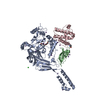
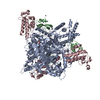
 要素
要素
 Homo sapiens (ヒト) / 参照: UniProt: Q1XA76
Homo sapiens (ヒト) / 参照: UniProt: Q1XA76 Micrurus tener tener (コブラ) / 発現宿主:
Micrurus tener tener (コブラ) / 発現宿主: 
 Micrurus tener tener (コブラ) / 発現宿主:
Micrurus tener tener (コブラ) / 発現宿主: 


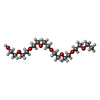




 X線回折 / 使用した結晶の数: 1
X線回折 / 使用した結晶の数: 1  試料調製
試料調製 シンクロトロン / サイト:
シンクロトロン / サイト:  ALS
ALS  / ビームライン: 5.0.2 / 波長: 1.378 Å
/ ビームライン: 5.0.2 / 波長: 1.378 Å 解析
解析 分子置換 / 解像度: 2.65→46.044 Å / SU ML: 0.33 / σ(F): 1.97 / 位相誤差: 25.85 / 立体化学のターゲット値: ML
分子置換 / 解像度: 2.65→46.044 Å / SU ML: 0.33 / σ(F): 1.97 / 位相誤差: 25.85 / 立体化学のターゲット値: ML ムービー
ムービー コントローラー
コントローラー





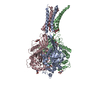
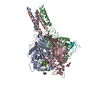



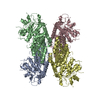


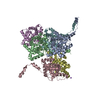
 PDBj
PDBj







